Lean meats refer to various types of meat with low-fat content, typically containing less than 8 grams of fat per 100 grams with less than 200 calories per serving. These lean meats are beneficial for individuals looking to manage their calorie intake while adhering to a high-protein diet.
According to the 2005 study conducted by Duo Li, titled “Lean Meat and Heart Health,” lean meats, especially lean red meats that have been trimmed of visible fat, were found not to elevate total blood cholesterol and LDL-cholesterol levels. The study suggested that they can promote weight loss and support a balanced diet. Li’s research ultimately concluded that lean red meat, when properly trimmed of visible fat and incorporated into a low-saturated-fat diet, does not increase cardiovascular risk factors.
Examples of lean meats include skinless poultry such as chicken or turkey, as well as lean cuts of pork and beef, often labeled with terms like “loin” or “round.” This article covers 15 types of lean meat, as outlined below. It also explains how incorporating lean meats into your healthy diet can support weight loss, thanks to their high protein content, which helps boost feelings of fullness.
- Chicken Breast
- Turkey Breast
- Pork Tenderloin
- Top Round Steak
- Venison
- Bison
- Rabbit
- Lamb Loin Chop
- Veal
- Pheasant
- Duck Breast
- Ostrich
- Goat Meat
- Elk Meat
- Wild Boar
1. Chicken Breast
Chicken breast is a lean cut of meat taken from the pectoral muscle of the chicken, known for its high protein content and low fat. Chicken breast, especially when it’s skinless and boneless, ranks among the leanest and most popular meat cuts. If you were to ask someone about what are examples of lean meats for a weight loss diet, they would likely mention chicken.
Chicken breast stands out as one of the best lean meats in terms of quality, protein content, and affordability. It’s a versatile choice for a wide range of omnivorous diets, whether you’re grilling, baking, or broiling it. Moreover, its low-fat content makes it a preferred option for health-conscious consumers.
As highlighted in a 2017 study by Débora Cristina Fernandes da Silva of the Federal Rural University of Semi-Arid, chicken breast is well-regarded as a healthy food source that boasts excellent nutrient composition – being high in protein but low in cholesterol, fat, and calories.
More specifically, a standard serving size of 100 grams of this lean meat offers 165 calories, a substantial 31 grams of protein, a trivial 3.6 grams of fat, and 85 mg of cholesterol, marking it as a highly nutritionally-valuable selection, as shown in this graph.
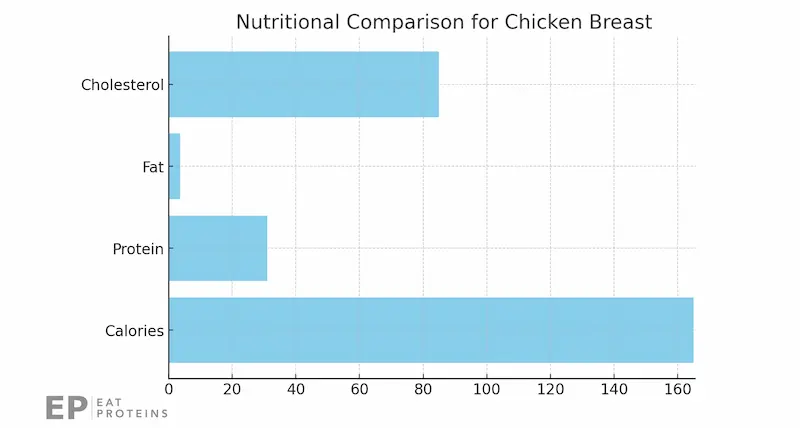
2. Turkey Breast
Turkey breast is the lean, white meat from the chest of a turkey, often roasted or sliced for healthy, protein-rich meals. The skinless, boneless portion of the turkey breast contains less than 1 gram of fat per 100 grams.
According to a 2018 study by F Gálvez at the Centro Tecnológico de la Carne de Galicia, the composition and nutritional value of turkey meat are influenced by the bird’s gender, with female turkeys presenting a more favorable fatty acid profile and higher levels of essential and non-essential amino acids.
Regardless of the cooking method, whether roasted or grilled, turkey breast makes for a tasty meal. It’s slightly less caloric than chicken, contributing just 135 calories per 100 grams.
This table shows nutritional information for turkey breast.
| Nutritional Information | Turkey Breast (per 100g) |
|---|---|
| Calories | 135 |
| Protein | 30g |
| Fat | 3.26g |
| Cholesterol | 70mg |
3. Pork Tenderloin
Pork tenderloin is a lean, tender cut of meat from the muscle that runs along the backbone of a pig. It can be prepared by baking, grilling, or sautéing. According to a 2016 study led by Cheol Woo Lee from Chungnam National University, dry-aged pork loin presented lower moisture and higher protein content, enhanced flavor due to increased free amino acids, and improved textural quality, affirming its excellent sensory evaluation.
A 100-gram serving of pork tenderloin contains only 143 calories, paired with a robust 26 grams of protein, a minimal 3.5 grams of fat, and 74 mg of cholesterol. Thus, pork tenderloin undeniably fits as a viable selection on a lean meats list.
4. Top Round Steak
Top round steak is a lean and flavorful cut of meat from the hindquarters of the cow, containing 7 grams of fat per 100 grams. While it may not be the cheap option among lean meats, it is often chosen for roasting or grilling.
In a 1999 study conducted by Ruth Neely from Texas A&M University with 2,212 consumers in multiple cities, it was found that top-round steak, when used in stir-frying, braising, and simmering or stewing, often resulted in higher consumer ratings. This graph displays the nutritional data.
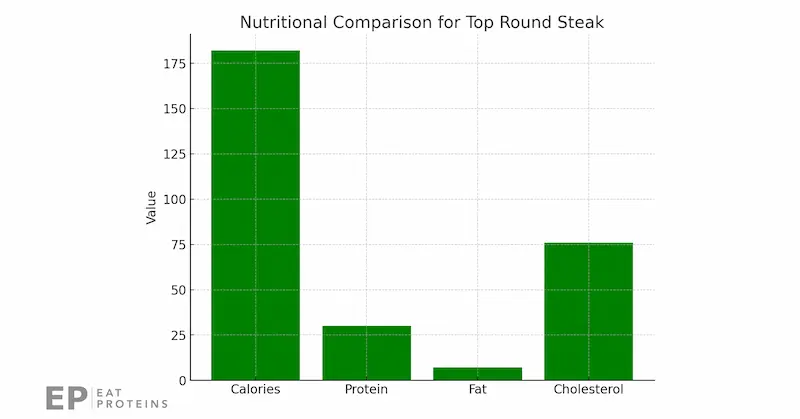
With 182 calories per 100 grams, it’s slightly higher in caloric content, but it offers a generous 30 grams of protein and 76 mg of cholesterol, making it a potent choice for grilling, broiling, or slow-cooking methods.
5. Venison
Venison is the meat of a deer, often prized for its gamey flavor and lean protein quality. Specifically, the loin and tenderloin cuts are excellent sources of lean protein. According to a 2006 study by Professor Louw Hoffman from the University of Stellenbosch, venison, along with game meat from southern Africa, has a low muscle fat content, consisting predominantly of structural lipid components like phospholipids and cholesterol.
According to the study, venison, a high-protein lean meat, is beneficial for a weight loss diet due to its favorable polyunsaturated to saturated and n-6 to n-3 fatty acid ratios. The study also highlighted that these meats are harvested in a sustainable manner using acceptable methods, fulfilling the requirements stipulated by the European Economic Community for meat imports. The study is titled “Game and Venison – meat for the modern consumer”.
When prepared through grilling or roasting, these cuts not only offer a compelling flavor but also nutritional benefits, as shown in this table.
| Nutritional Information | Venison (per 100g) |
|---|---|
| Calories | 158 |
| Protein | 30g |
| Fat | 3g |
| Cholesterol | 95mg |
6. Bison
Bison meat is the lean, nutrient-rich meat from the American buffalo, known for its deeper flavor compared to beef. Bison lean meat is suitable for most low-fat diets because nutritionally, a 100-gram serving of bison provides a substantial 146 calories, 20 grams of protein, a mere 7 grams of fat, and contains only 98 milligrams of cholesterol.
In a 2023 study conducted by Stephan van Vliet from Utah State University, significant differences were found between pasture-finished and pen-finished bison meat in terms of their metabolomic, lipidomic, and fatty acid profiles. Despite these differences, both types of meat maintained favorable omega 6:3 ratios, amino acid compositions, and vitamin profiles.
Ultimately, the study concluded that pasture-finished or grass-fed bison improves the metabolic health of the bison and accrues additional health-promoting compounds in the meat, though the specific impact on human health remains to be determined fully.
7. Rabbit
Rabbit meat is lean, tender white meat from rabbits, often praised for its high protein content and low fat and cholesterol levels. Rabbit meat is suitable for hearty dishes like stews and braises, with the loin and leg cuts being the leanest. According to a 2011 study by Antonella Dalle Zotte from the University of Padova titled “The Role of Rabbit Meat as Functional Food,” rabbit meat is considered a functional food because it contains numerous functional compounds.
Dietary manipulation has been seen to be very effective in increasing the levels of essential FA, EPA, DHA, CLA, branched-chain fatty acids, vitamin E, and selenium in rabbit meat.
Antonella Dalle Zotte, Professor of Animal and Meat Science
A 100-gram serving of rabbit meat contributes 173 calories, a significant 29 grams of protein, a minimal 4 grams of fat, and 100 mg of cholesterol, indicating its suitability for a high-protein and low-fat diet plan.
8. Lamb Loin Chop
A lamb loin chop is a tender, T-bone meat cut from the waist of the lamb, featuring a portion of the loin muscle on one side and a smaller piece of tenderloin on the other. The lamb loin chop, a healthy and lean meat option, is popular for its tender consistency, making it ideal for grilling or roasting. The lamb loin chop is one of the best types of lean meats to eat on the carnivore diet.
In each 100-gram serving of lamb loin chop:
- Calories: 176
- Protein: 23 grams
- Fat: 5 grams
- Cholesterol: 71 mg
In a 2008 study conducted by K. M. Angood from the University of Bristol, it was found that organic lamb chops exhibited superior eating quality compared to conventional lamb, showing higher levels of juiciness, flavor, and overall liking. These differences in quality were attributed to the elevated intramuscular fat content and improved fatty acid composition of organic meat, notably the increased levels of linolenic acid (18:3) and total n-3 polyunsaturated fatty acids (PUFA).
9. Veal
Veal is the lean meat from young calves, often prized for its tender texture and mild flavor. The leanest cuts occur in the loin and leg, and a standard 100-gram serving of these cuts yields 160 calories, 27 grams of protein, 5 grams of fat, and 75 mg of cholesterol.
In a 1991 study conducted by M. Dijkstra from Instituut voor Veeteeltkundig Onderzoek, which involved multiple trials with calves fed various diets, reducing the milk substitute amount in their feed and partially substituting it with maize silage or a silage-concentrate mix resulted in cost-effective growth and a change in the color of the veal. Importantly, these changes did not significantly affect other meat quality parameters such as tenderness and flavor.
10. Pheasant
Pheasant meat is the gamey, lean flesh from the pheasant bird, often valued for its rich flavor in culinary dishes. When roasted or grilled, a 100-gram serving of pheasant lean meat provides 144 calories and boasts 28 grams of protein, making it suitable for most low-carb diets.
According to a 2013 study by D Franco of Fundación Centro Tecnológico de la Carne, common pheasant meat, specifically from 10-month-old fowl maintained in an extensive rearing system, demonstrated several nutritional qualities. The breast meat had a high protein concentration of 254g/kg and a low intramuscular fat content of 1.3g/kg. In comparison, the drumstick had a protein content of 222g/kg and a higher intramuscular fat content of 4.0g/kg.
Pheasant lean healthy meats also boast a commendable mineral content, with noticeable variations among muscle types in terms of iron, magnesium, sodium, and zinc. Emphasizing its nutritional benefits, 100g of pheasant drumstick provides 23.6% of the recommended daily amount of iron, as illustrated below.
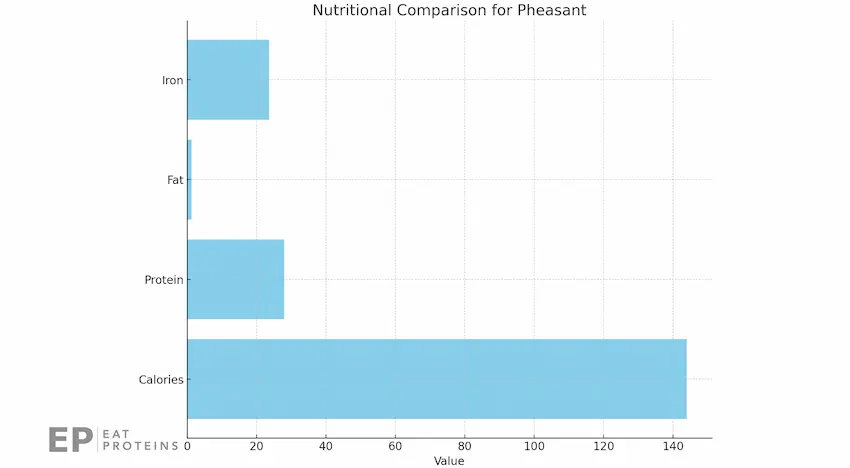
11. Duck Breast
Duck breast is the meat from the chest of a duck, celebrated for its rich flavor and tender texture. Once the skin is removed, duck breast is classified as one of the very lean meats. According to a 2011 study by J M Lorenzo from Centro Tecnológico de la Carne de Galicia, dry-cured duck breast stands out from other dry-cured meats due to its low moisture level and higher protein content. The study also revealed the presence of essential amino acids like lysine and leucine, along with macro minerals such as iron, zinc, copper, and manganese.
This table shows the nutritional value of skinless duck breast.
| Nutritional Information | Skinless Duck Breast (per 100g) |
|---|---|
| Calories | 142 |
| Protein | 23g |
| Fat | 3g |
| Cholesterol | 79mg |
A 100-gram serving of skinless duck breast, either roasted or grilled, contains 142 calories, 23 grams of protein, 3 grams of fat, and 79 mg of cholesterol.
12. Ostrich
Ostrich meat is a lean, red meat sourced from the flightless bird native to Africa, known for its rich flavor and low-fat content. While ostrich is considered one of the top lean meats available, it is not easily accessible. Ostrich lean meat is suitable for Ketogenic and Atkins diets. A 100-gram serving of ostrich meat provides 189 calories, an impressive 28 grams of protein, a meager 3 grams of fat, and 87 mg of cholesterol, reaffirming its place on the list of lean meats.
A 2021 study by Olaf K Horbańczuk from the Warsaw University of Life Sciences explored the changes in antioxidant enzyme activity and free radical scavenging activity in ostrich meat under various packaging systems and refrigeration storage times. These antioxidants include enzymes like superoxide dismutase (SOD), glutathione peroxidase (GPx), and glutathione reductase (GR), which play important roles in maintaining the health and freshness of the meat.
The study found that vacuum packaging resulted in the lowest level of SOD activity over time, which suggests that vacuum packaging may better preserve the antioxidant properties of ostrich meat.
13. Goat Meat
Goat meat is the culinary term for the meat of domestic goats, renowned for its lean and distinctively flavored red meat. It is a lean, low-fat meat commonly used in substantial stews and braises. According to a 1990 study by S A Babiker from the University of Khartoum, goat meat contains notably less intramuscular fat and more moisture compared to lamb. The concentrations of sarcoplasmic proteins were also higher in goat meat, making it darker in color compared to lamb, while myofibrillar protein levels were identical in both types of meat.
Furthermore, goat meat demonstrated superior water-holding capacity and less cooking loss. Despite being less flavor-intense than lamb, it brings considerable nutritional value, as shown in this graph.

The leanest cuts from the goat are the loin and leg. A 100-gram serving of these cuts carries 193 calories and offers 20 grams of protein, a maximum of 2 grams of fat, and 81 mg of cholesterol.
14. Elk Meat
Elk meat is a type of lean, gamey red meat that comes from the elk, a large species of deer known for its rich flavor and nutritional benefits. Elk meat is considered a very lean meat, as it is low in fat and high in protein, particularly the loin and sirloin cuts. A 100-gram serving of elk meat delivers only 193 calories, along with an impressive 30 grams of protein, a mere 2 grams of fat, and 59 mg of cholesterol.
Despite its nutritional advantage, a 2019 study by Ibironke O Popoola of the University of Alberta points out that there is significantly lower consumption of elk, along with other alternative red meats like bison and horse, compared to beef.
Elk was associated with a liver-like, slightly fishy, metallic flavor, musky aroma, and bloody aftertaste. However, despite these negative associations, the results showed that a small group of consumers preferred horse and elk meats, suggesting niche market opportunities for these meat types.
15. Wild Boar
Wild boar meat, derived from feral descendants of domestic pigs, is known for its rich, gamey taste and distinctive flavor. Particularly in its loin and leg cuts, this lean meat offers a unique, strong, nutty profile while being protein-rich.
As explored in the 2013 study “Meat from wild boar” by James Sales, published in the Meat Science Journal, wild boar have been increasingly considered for meat production due to increases in natural populations and potential for farming.
Compared to domestic pigs, wild boars have greater carcass fatness, larger loin areas, and more certain muscle fibers, resulting in leaner, darker, and less tender meat. Different diets can contribute to variations in cooked meat flavor and fatty acid content between wild boars and domestic pigs.
The high α-tocopherol concentrations in wild boar could extend its meat’s shelf life. Various techniques such as mechanical massaging of muscles, vacuum package aging, and marinating have been tried to make wild boar meat more tender. A 100-gram serving of wild boar offers 196 calories, 30 grams of protein, a mere 2 grams of fat, and 72 mg of cholesterol.
What are the lean meats?
Lean meats are those with low-fat content, typically under 10 grams of total fat and less than 4.5 grams of saturated fat per serving; this includes skinless poultry, most fish, and cuts like round, sirloin, and tenderloin.
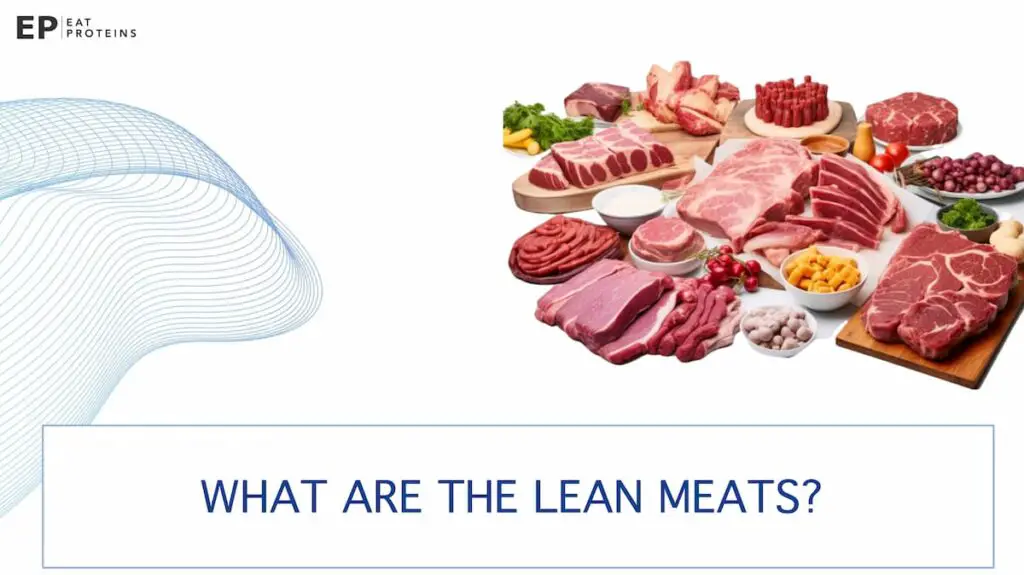
To qualify as lean meat, a 3.5-ounce serving should contain less than about a third of an ounce of total fat, roughly a sixth of an ounce of saturated fat, and 95 milligrams of cholesterol.
Which lean meats are highest in protein?
Skinless turkey and chicken, as well as round cuts of beef, deliver the highest protein content per ounce while keeping fat to a minimum. The best place to find these lean meats with high protein content is at a butcher shop.
However, if that’s not an option, your next best bet is your local supermarket. Commonly available lean meats at supermarkets include skinless poultry, pork tenderloin, and extra-lean ground beef. To spot lean meats, check the labels for the words ‘loin’ or ’round,’ or look for a visible lean-to-fat ratio, like 90/10, on the packaging.
What are the best lean meats for weight loss?
The best lean meats for weight loss are those high in protein but low in saturated fats, like skinless chicken breast, turkey, and lean cuts of beef. Lean meats contribute to weight loss by providing high protein content, which can increase satiety and help maintain muscle mass while cutting calories.
What are the best types of lean meats for a balanced diet?
For a balanced diet, include a variety of lean meats like chicken, turkey, fish, and occasional lean beef or pork to cover all your nutrient bases. Keto diet enthusiasts often go for fattier cuts, but if you want to keep it lean, opt for meats like chicken breast, turkey, and lean cuts of beef or pork. On the other hand, Weight Watcher’s zero-point meats are usually skinless chicken or turkey breast, since they’re high in protein and have no Points value on their Blue and Purple plans; just watch the portion sizes to maintain balance.
What are the best types of lean meats for an Optavia diet?
On an Optavia diet, you’d want to stick with their recommended lean and green meals, so think grilled chicken, steamed fish, or even game meats like venison.
Which lean meats are included in the Optavia Meat List?
The lean meats included in the Optavia meat list are turkey, chicken, duck, and pork. While these meats are similar to those found on other lean meat lists, the key distinction with the Optavia meat list is the recommended serving size, which typically ranges between 5-7 ounces.
What are the top 5 leanest meats?
The top five leanest types of meat, considering the balance between low calories, low fat, and high protein, are turkey breast, chicken breast, duck breast, pork tenderloin, and bison, as shown in this graph.
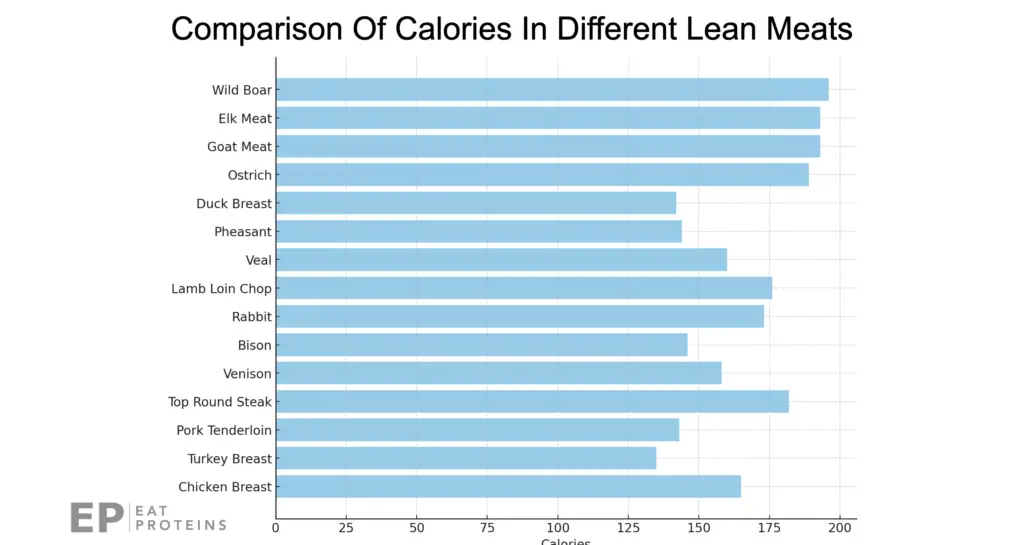
These meats provide substantial protein while maintaining relatively low caloric and fat content, making them ideal choices for a lean diet.
